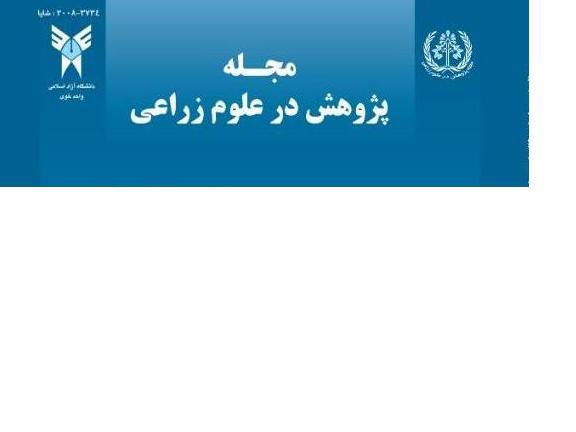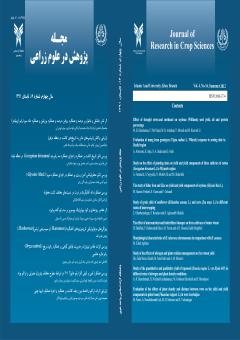ارزيابي واکنش ژنوتیپ¬های ماش به تاریخ¬های کاشت در منطقه دزفول
محورهای موضوعی : توليد محصولات زراعي
کلید واژه: : تاریخ کاشت, رقم, عملکرد و اجزاء عملکرد, ماش ,
چکیده مقاله :
به منظور بررسی اثر تاریخ کاشت بر عملکرد و اجزاء عملکرد ژنوتیپ¬های ماش آزمایشی در سال 1386 در مزارع شرکت کشت و صنعت شهید بهشتی دزفول به صورت فاکتوریل در قالب طرح بلوک¬های کامل تصادفی با چهار تکرار به اجرا درآمد. ژنوتیپ¬ها شامل ارقام ماش در چهار سطح بنام (V1) 960-8-VC3، (V2) NM92، (V3) گوهر و (V4) CN-9-3 و تاریخ کاشت (D) در سه سطح شامل 1/4/1386 (D1)، 15/4/1386 (D2) و 30/4/1386 (D3) بودند. در این تحقیق صفات تعداد غلاف در بوته، تعداد دانه در غلاف، وزن هزار دانه، عملکرد دانه، عملکرد بیولوژیک، شاخص برداشت، طول غلاف و ارتفاع بوته مورد مطالعه قرار گرفتند. نتایج بررسی نشان داد که اثرات ساده تاریخ کاشت و رقم و اثر متقابل تاریخ کاشت و رقم بر اغلب صفات مورد مطالعه معنی¬دار بود. مقایسات میانگین نشان داد که در تاریخ کاشت اول بیشترین عملکرد دانه ( kg/ha7/2019)، عملکرد بیولوژیک (kg/ha 5287) و تعداد غلاف در بوته (23 عدد) بدست آمد. بیشترین وزن هزار دانه متعلق به تاریخ کاشت دوم و برابر60 گرم و بیشترین تعداد دانه در غلاف (10 عدد) و شاخص برداشت معادل (41) درصد در تاریخ کاشت سوم بدست آمد. بررسی اثرات رقم و مقایسات میانگین صفات مختلف در ارقام نشان داد که لاین NM92، بیشترین تعداد غلاف در بوته (34 عدد)، تعداد دانه در غلاف (12 عدد)، طول غلاف (1/9 سانتی¬متر)، ارتفاع بوته (6/89 سانتی¬متر)، عملکرد دانه (kg/ha 2/2362) و عملکرد بیولوژیک (kg/ha 6489) را دارا بوده و نسبت به سایر ژنوتیپ¬ها در این آزمایش برتری داشت. نتایج بررسی اثرات متقابل تاریخ کاشت و رقم نشان داد که تیمار D1V2 با عملکرد دانه 2/2662 کیلوگرم در هکتار و با تعداد 36 غلاف در بوته و تیمار D1V3 با تعداد 13 دانه در غلاف مناسب¬ترین تیمار بود. با توجه به نتایج اثرات متقابل بدست آمده در این بررسی مشخص گردید لاین NM92 (V2) در تاریخ کاشت اول تیرماه (D1) به عنوان بهترین ژنوتيپ در این منطقه شناخته شد.
To study the effect of sowing time on yield and yield components of mung bean genotypes an investigation was carried out during 2007 in Dezful region in complete randomized block design with four replications. Mung bean genotypes were in four levels (V1) VC3-960-8, (V2) NM92, (V3) Gohar and V4 (CN-9-3) and also sowing times were in tree levels (D1) 22 June, (D2) 6 July and (D3) 22 July 2007. Results of mean comparisons showed that the first sowing date (D1) obtained the highest grain yield (2019.7 kg/ha) and biological yield (5286.6 kg/ha) and pods in plant (23) respectively. Results also showed highest thousand kernel weight (60g), number of seeds in pod (10) and harvest index (41%) were obtained in (D3). Further study of the genotypes effects and comparisons of the mean difference of traits showed the highest number of pods in plant (34), number of seeds in pod (12), pod length (9.1 cm), plant height (89.6 cm), grain yield (2362.2 kg/ha), biological yield (6489 kg/ha) obtained in NM92 genotype. NM92 genotype variety yielded a better performance than other genotypes. Results of interaction effects of sowing date and genotypes showed that D1V2 treatment with 2662.2 kg/ha grain yield and 36 pods per plant were the most appropriate. D1V3 treatment with 13 seeds in pod was the best treatments. The overall conclusion being that the first planting date (D1) and NM92 (V2) genotype are better than other genotypes for cultivation of mung bean in Dezful region.
منابع مورد استفاده References
Abdur Rahman Sarkar, M. D., H. K. Mahfusa Begum, and M. D. Abdus Salam. 2004. Yield performance of mung bean as affected by planting date, variety and plant density. Department of Agronomy. Bangladesh Agricultural University, My Mensingh, Bangladesh. Journal of Agronomy. 3 (1): 18- 24.
ABU Kawsar Miah, M. D., M. D. Parvez Anwar, B. Mahfuza, A. Juraimi, and M. D. Anwarrul Islam. 2009. Influence of sowing date on growth and yield of summer mung bean varieties. Journal of Agriculture and Social Sciences. Pp: 73- 76.
Ali ghani, M., A. Ghalavand, and A. Afrasyab. 2005. Effect of plant density on yield, yield component of two variety and one line green mung bean in Karaj, Journal of Agriculture Science and Technique and Natural Resources. 9: 111- 120. (In Persian)
Dhanjal, R. O., A. Parkash, and I. P. S. Ahlawat. 2000. Response of spring green gram to dates of sowing. Ann. Agric. Res. 21: 570- 571.
Dharmalingam, C., and R. N. Basu. 1993. Determining optimum season for the production of seeds in mung bean. Madras Agric. J. 80: 684- 688.
Fathee, G. 2005. Effect of plant density on growth, seed yield and yield component of mung bean varieties in spring sowing, 1th national conference of cereal, Institute of Plant Science Ferdoosy University of Mashhad. Pp: 34- 36. (In Persian)
Habib zadeh, Y. 2006. Effect of plant density on yield and morphological characteristic of three mung bean genotypes in Ahwaz conditions. Journal of Agronomy Science of Iran. 8 (1): 66- 78. (In Persian)
Haqqani, A. M., and R. K. Pandey. 1994. Response of mung bean to water stress and irrigation at various growth stage and plant densities, yield and yield component. Tropical Agriculture. 71(4): 289- 294. (In Persian)
Khorramian, S. 2010. Effect of low irrigation and Plant density on yield of four mung bean variety in Iezeh city. M.Sc thesis agriculture on agronomy. Islamic Azad University Dezfoul Branch. (In Persian)
Lamping, A. N., S. Pichitporn., S. Sinisingh, and N. Vanakijmongkol. 1988. Mung bean growth pattern in relation to yield. Agron. J. 74: 164- 168.
Majnon hossiany, N. 2004. Cereal in Iran, Academic Jihad Publications of Tehran University. (In Persian)
Mohammad pour, A. 2005. Physiological growth variation and yield components of vigna radiate (NM92) affected planting pattern, M.Sc thesis agriculture on agronomy. Islamic Azad University Dezfoul Branch. (In Persian)
Nanda, R., and D. Saini. 1987. Effect of temperature, day- length and humidity on the leaf appearance in green gram. Indian J. of Agric. Sci. 57 (9): 645- 650.
Panwar, J. D. S., and G. S. Sirohi. 1987. Studies on effect of plant population of grain yield and is components in mung been (vigna radialabl. Wilozeik). Indian Journal of Plant Physiology: 4: 412- 414.
Poehlman, J. M. 1991. The Mung bean, 1st edition, Pp: 27- 29. Oxford and IBH. Publishing. Co.Pvt. Ltd., New Dehli, India.
Rana, A. F., I. Javaid, and A. H. Muhammad. 2006. Effect of sowing dates and planting patterns on growth and yield of mung bean (vigna radiate L.) CV.M-6. International Journal of Agriculture Biology. Pp: 363- 365.
Rezaei, A., and A. Hassan zadeh. 1995. Effect of sowing date and Plant density on yield, yield components and their vertical distribution in three mung bean variety. Journal of Agriculture Science. 26 (2): (In Persian)
Sangakkara, U. R. 1998. Impacts of planting time on seed yield and quality of mung bean. Thai J. Agric. SCI. 31: 352- 359.
Soomro, N. A. 2003. Response of mung bean genotypes to different dates of sowing in kharif season under rain fed condition. Asian J. Plant Sci. 2: 377- 379.
Talei, A., N. Khoda bandeh, and B. Gholamy. 1995. Evaluation sowing date effects on yield and yield component and mung bean protein percent. Journal of Agriculture Science of Iran. 26 (4): 751- 758. (In Persian).

